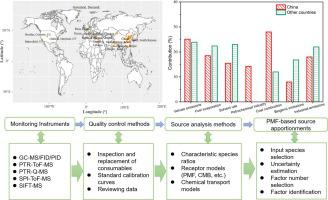Environment International ( IF 11.8 ) Pub Date : 2022-05-31 , DOI: 10.1016/j.envint.2022.107330 Yang Yang 1 , Baoshuang Liu 1 , Jing Hua 2 , Tao Yang 1 , Qili Dai 1 , Jianhui Wu 1 , Yinchang Feng 1 , Philip K Hopke 3

|
Highly time-resolved data for volatile organic compounds (VOCs) can now be monitored. Source analyses of such high time-resolved concentrations provides key information for controlling VOC emissions. This work reviewed the literature on VOCs source analyses published from 2015 to 2021, and assesses the state-of-the-art and the existing issues with these studies. Gas chromatography system and direct-inlet mass spectrometry are the main monitoring tools. Quality control (QC) of the monitoring process is critical prior to analysis. QC includes inspection and replacement of instrument consumables, calibration curve corrections, and reviewing the data. Approximately 54% published papers lacked details on the quantitative evaluation of the effectiveness of QC measures. Among the reviewed works, the number of monitored species varied from 5 to 119, and fraction of papers with more than 90 monitored species increased yearly. US EPA PMF v5.0 was the most commonly used (∼86%) for VOC source analyses. However, conventional source apportionment directly uses the measured VOCs and may be problematic given the impacts of dispersion and photochemical losses, uncertainty setting of VOCs data, factor resolution, and factor identification. Excluding species with high-reactivity or estimation of corrected concentrations were often applied to reduce the influence of photochemical reactions on the results. However, most reports did not specify the selection criteria or the specific error fraction values in the uncertainty estimation. Model diagnostic indexes were used in 99% of the reports for PMF analysis to determine the factor resolution. Due to lack of known local source profiles, factor identification was mainly achieved using marker species and characteristic species ratios. However, multiple sources had high-collinearity and the same species were often used to identify different sources. Vehicle emissions and fuel evaporation were the primary contributors to VOCs around the world. Contribution of coal combustion in China was substantially higher than in other countries.


























 京公网安备 11010802027423号
京公网安备 11010802027423号